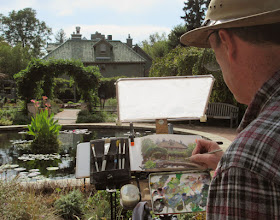Tad asks: "I noticed your recommended basic sets of colors are different, depending on the medium. Did your habits change between videos or does the transparency differences between gouache and watercolor require a different set to get the most flexibility?
Hi, Tad, I take a different set of colors each time I travel. I'm always trying new pigments in new combinations. I usually start out with a commercial
watercolor pan set, which I customize by replacing some of the colors. I bring along a few tubes of gouache or watercolors, because the paint from tubes is juicier than the paint dried in pans. I carry the tubes in a little
plastic snack box or in a plastic bag.
Those extra tubes of gouache are from sets offered by
Holbein,
M. Graham, or
Winsor and Newton. It costs a lot less per tube to buy them in sets rather than individually. I also sometimes pull unusual colors from the big set of
Shinhan Pass, which is a watercolor/gouache hybrid. I also have a big jar of
Richeson (casein), which I use when I want to work in a broader, more painterly style.

Although the set of colors that I actually bring in my kit evolves or changes on a given outing changes, I typically bring one or two reds, a couple yellows, and a couple blues, plus white. I like to have a high-chroma and a low-chroma version of each one. For example I might have
cadmium yellow and
yellow ochre, but next time I may want to change out the cadmium for a
lemon yellow.
When I start a painting, I select even further from the 6-12 tubes of colors that I have in my kit, because I don't want to squeeze out any more colors than I actually need. If midway through a painting I find I need an additional color that I haven't squeezed out yet, I add that midway through.














































